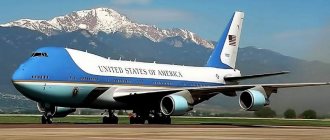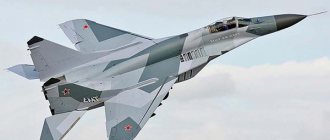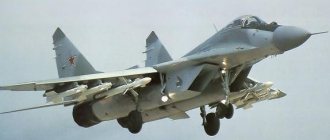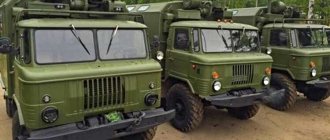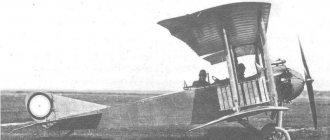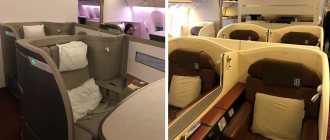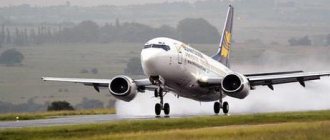History of the aircraft
At the end of the sixties of the last century, aviation flourished in the world. Passengers preferred to travel by plane, and the high demand for air tickets prompted designers to design a huge airliner that could accommodate up to 500 passengers.
The first model of the double-decker Boeing took off in 1969. It was a passenger airliner capable of non-stop flight over a distance of up to 10,000 km. American engineer Joe Sutter is considered its creator. Previously, he worked on the Boeing 737 and heavy transport aircraft for the US Air Force.
Boeing 747 assembly
In the bow of the new airliner there were 2 decks, they were located above each other, which made the plane itself seem a little humpbacked. The pilot's cabin was on the upper tier. It is no coincidence that the developers made the hull of the airliner in exactly this shape. They thought that the Boeing 747 would soon be replaced by supersonic aircraft. The resulting board was going to be used for transport purposes. In addition, the airliner was equipped with 4 engines and consumed too much fuel during the flight.
However, subsequent Boeing models were improved and became more economical. For 50 years now, the Boeing 747 has taken off into the sky every day, transporting air passengers and being one of the heaviest and most spacious aircraft. The cost of the latest model 747-8 aircraft is $379 million.
Chronicles of the appearance of the airliner
The aviation industry flourished in the sixties of the twentieth century. At this time, leading US designers set out to create large-sized transport for transporting 400–500 people. After all, the high demand for air tickets in those years caused a shortage of new generation aircraft. Engineers developed a design for the vessel based on the previous model, the Boeing 737. Moreover, the aviators’ first idea was to create a cargo-passenger airliner.
The Boeing 747 was the first wide-body airliner and remained the largest passenger aircraft for 35 years.
Such extraordinary thinking of the developers explained the appearance of the first modifications of supersonic passenger airliners. Scientists assumed that this series would not be able to compete with high-speed aircraft in the near future, and provided a backup option. This solution determines the design and some technical characteristics of the Boeing 747 400.
The crew cabin is on the upper deck here, since the plans planned to allocate the lower sector for cargo transportation. And the maximum take-off weight of the first sample board of 370 tons spoke about the potential of using such vessels for cargo transportation.
The project was gradually refined and modernized. By 1976, aviators abandoned the idea of making the fuselage of the airliner into two full decks and settled on proposing a modern type of modification with a “hump.” Here the upper compartment accommodates the cockpit and up to 50 passenger seats. In terms of people transport potential, the capacity of the Boeing 747 400 is amazing. The aircraft lifts up to 660 passengers, which was considered a world record before the advent of the Airbus A380 .
The first flight of this model was carried out in 1970
Initially, 25 units of the 747 100 series were produced. Subsequently, the company periodically modernized the invention, changing the wingspan and the design with the position of the landing gear. In addition, over the history of production of ships of this class, the take-off weight of the airliner increased by 16% and amounted to 442 tons on board the 747-8. Today this large-scale project is closed, but airlines use such equipment on transcontinental flights.
The first experimental flight of the new series took place in 1970 of the twentieth century. It is noteworthy that the largest fleet of these aircraft was on the airline’s balance sheet. However, today this carrier has completely abandoned such ships.
An interesting fact in the history of aircraft development was the fuel crisis, as a result of which the use of such giants temporarily brought losses. Even to produce the planned number of first models, the designers took out loans, since the company did not have such a significant amount. True, over time, the costs paid off in full and tripled the funds spent on development.
Cabin configuration
Boeing 747 has 2 decks. Business class passengers are accommodated on the top. On the bottom: in the bow there is business class, and behind it in several salons there are seats for economy class passengers. The cockpit is located at the top. You can climb to the upper tier by stairs.
The upper deck can accommodate 50 air passengers. The Boeing's upper cabin can be divided into two sections - immediately behind the cockpit there are 3 rows for business class passengers, and behind them there are 9 rows for the VIP area. The most spacious Boeings, on the contrary, give the upper tier to economy class. The seating arrangement is 2 and 2 in each row. There is a passage between the block of two seats.
Boeing 747-400 cabin layout
The passenger capacity of the lower tier is 300–500 people. The seats are arranged in three blocks. On the sides there are blocks of 3 or 2 (for the tail and bow) seats, in the middle there is a block of 4 seats. The cabin has about 60 rows. They are divided into several sections. There are 3 blocks in each row, which corresponds to 10 seats. There are 2 passages between 3 blocks. The presence of two aisles is a distinctive feature of wide-body aircraft.
Advantages of the vessel design
Now let's talk about the merits of the series. The appearance of such aircraft became a new word in the field of aviation - after all, before Boeing there were no wide-body models. The board is equipped with four powerful jet engines, which has a positive effect on speed characteristics and flight range. The cruising speed of a Boeing 747 passenger aircraft in flight is 910–950 km/h .
Improved aerodynamic performance contributes to the development of cruising speed of 910-950 km/h
In addition, the aircraft flies a distance of 14,205 kilometers without refueling. Moreover, these indicators apply to a loaded airliner. The passenger capacity of the Boeing 747 is up to 660 people. In addition, the ship can accommodate luggage, two pilots, a flight engineer and flight attendants. It’s not for nothing that the model is called the “Jumbo Jet” or the king of the skies - before the advent of Airbus, this series of aircraft was the leader in the category of passenger transportation.
The aircraft's aerodynamic performance surpassed the previous series - 737. Here the wings were highly modernized - with a wing height of 6 meters and a wingspan of 60 meters, engineers achieved fuel savings of 3.5% and an increase in flight duration.
Of course, the interior of the aircraft requires a separate description. Here the designers have provided 2 passages, and the total width of the passenger sector is 6.13 meters. The cockpit was also changed here, making the room convenient to use. The changes increased the comfort of transportation and improved flight conditions for the crew. Let's take a closer look at the nuances of the parameters of the internal compartment of the airliner.
Interior layout
The interior design of the ship has two decks. The lower tier occupies the entire length of the aircraft, and the upper tier – 35%. On top, the developers placed a crew cabin and 9 rows of highly comfortable seats. Various models require the installation of business class seats in this part of the aircraft. On most of these aircraft used in Russia, on the top floor the first three rows are reserved for the Business fare, and the remaining 5 are for improved economy flights.
Boeing 747 400 flight deck
As for the pilot's cockpit, outdated dial instruments have been replaced with modern liquid crystal displays. This fact made it easier to control the aircraft. Moreover, to get to the upper tier of the plane, passengers and pilots use a straight staircase, not a spiral staircase. The upper deck is equipped with two descents on both sides, which facilitates emergency evacuation in emergency situations.
The gigantic dimensions of the airliner allowed the developers to increase the space for installing passenger seats. In addition, the width of the 747 series aircraft for carrying carry-on luggage is higher than that of previous Boeing models.
The aircraft's three-class cabin can carry up to 416 people.
The board design assumes three cabin layout configurations: for one, two or three classes. In the first situation, the airliner is carrying 660 people. Models in two classes are the most common. Such series of airliners 747 400 are listed on the balance sheet of the Rossiya Airlines flotilla . It has a typical passenger capacity of 594 people. And aircraft in three comfort classes can accommodate up to 416 clients.
Technical specifications
Today, the Boeing 747 remains the longest aircraft in the world. The length of the aircraft hull reaches 70.6 m with a height of 19 and a half meters. The wing area of this giant is 511 m², and the empty vessel weighs 180.8 tons. In order for the board to rise into the air without hindrance, the engineers provided for the installation of powerful engines - the 747 models are equipped with four dual-circuit turbojet engines .
Boeing 747 is the longest plane in the world
The takeoff speed of a Boeing 747 is 270 km/h - it is at this rate that the aircraft's landing gear lifts off the runway. And the maximum take-off weight here ranges from 363.2–412.78 tons. The vertical wing tip increases the aerodynamics of the side and contributes to fuel economy. The maximum altitude at which this giant flies is 13,750 meters.
Among subsonic passenger airliners, the Boeing 747 is the leader in travel speed. Moreover, the technical parameters of the aircraft make it possible to increase the commercial load of the aircraft to 70,620 kilograms.
To improve speed and aerodynamic performance, engineers improved the fuselage design, balancing the huge wings with additional tail tanks. Among the most common and used modifications of this series, aviators call the 747 400 and 747 400ER . Until recently, such models formed the basis of the long-haul fleet of world airlines.
Where are the best seats on the plane?
In the cabins of different 747 models, seat placement has its own characteristics. You should first study the seating layout of the selected airliner. All Boeing aircraft have areas for business and economy class passengers. Models of this version are silent. Passengers will feel the least noise and vibration in the bow; the best seats are at the head of the aircraft on the second tier. As a rule, business class seats are located there. The seats in this section transform into a full bed. The distance between rows is 1.5 m.
Business class passengers have a more varied menu, free drinks, access to Wi-Fi, and a 15.4-inch monitor.
In economy class, the distance between the seats is no more than 0.9 m. The back of the chair can be lowered slightly. There are 3 blocks of bathrooms on the lower deck. True, it’s better not to take seats near the toilets. It is best to sit in the forward part of the lower tier.
The future of the 747
With the development of aviation, many carriers began to need the possibility of long flights without refueling, and therefore the developers again took up the Boeing 747. Passenger capacity in new versions reached up to 800 people. The flight range met the standards of the previously released 747-400 model. But very soon the 747-500 and 747-600 aircraft projects went into the archives. The carriers wanted a new aircraft, not a modernization of the old one. Nevertheless, the developers did not forget about the 747: they modified it, closed it, and modified it again. This continued until 2005. Finally, after the release of the Boeing 787, the corporation announced the return of the 747 model. The new aircraft is codenamed Boeing 747-8, or Advanced.
Carriers, remembering the dubious success of the first versions of the 747, initially ordered 109 aircraft - a third of them in passenger design. The rest were required in the cargo version. A total of 121 vehicles have been sold to date. The capacity of the Boeing 747-8 was not staggering - 581 people using 2 classes of service. By using three classes of service (with the addition of first class), the number of seats is reduced to approximately 400.
Design
The Boeing 747 has an interesting design - a hump in the front nose. The plane has 2 decks, although the top one is shortened by a third. The Boeing 747 is a low-wing aircraft with swept wings. The plumage is single-finned. The wing has three-slot Fowler flaps. They help reduce speed when landing on short runways.
Boeing 747 layout diagram
Boeing has 4 engines. Fuel tanks are located in the wing and tail. The cockpit is located on the upper deck. The Boeing landing gear consists of one nose and four main legs. There are 2 wheels on the bow strut, and 4 wheels on the main struts.
First flights
Despite financial difficulties, the first wide-body airliner took off in 1970. Since the airliner was a passenger one, the upper deck became a service deck, and all passengers were accommodated according to the principle usual for other aircraft. The capacity of the first Boeing 747 models was only 200 people, but if you compare it with the 737 model, released the same year and taking 100 people on board, the difference is twofold.
Active interest in the new airliner significantly undermined the position of the Concordes - supersonic European aircraft: many carriers revised their orders and shares of the Boeing 747 began to grow rapidly. Based on the first aircraft, production of several modifications began. The first of them was developed for a Japanese carrier, and the order was for short-range aircraft. The response to the Japanese order was the modification 747-100SR. This version received an improved fuselage and smaller tanks, thereby significantly increasing the aircraft's capacity. The Boeing 747-100SR was able to carry 500 and then 550 people. Later, the 747-300 development will receive the same modification - an aircraft flying short distances.
Flight performance
Technical parameters and characteristics of the aircraft:
- maximum speed - from 955 to 988 km/h;
- cruising speed - from 0.84 to 0.85 M;
- aircraft capacity - from 366 to 660 people;
- flight altitude - 13750 m;
- non-stop flight distance - from 9800 to 14815 km;
- dimensions of the airliner (fuselage length) - from 70.6 to 76.3 m;
- fuselage width - 6.5 m;
- height - 19.4 m;
- wing area - 541 sq. m;
- fuel consumption - 5,000 l/h;
- empty weight of the aircraft - from 162 to 214 tons;
- maximum take-off weight (carrying capacity) - from 340 to 442 tons;
- fuel reserve - from 183 to 424 thousand liters;
- run length - up to 3300 m.
Have you ever flown on a Boeing 747?
Not really
Boeing 744. General characteristics
The Boeing 744 is an economical airliner. The designers managed to find a successful combination of powerful engines that do not consume too much fuel during operation. Before the release of the Airbus 380, the Boeing 747 was considered the largest passenger airliner, as it could accommodate 524 people on board. Boeings occupy a significant share of the aircraft fleet of most of the world's leading airlines because they are economical, unpretentious and, with a high capacity, cover more than 14 thousand kilometers without refueling.
Boeing aircraft designers solved an extremely difficult problem - getting rid of strong noise in flight. For this purpose, new engines have been designed and proprietary materials have been developed to suppress noise.
The Boeing 744 has two decks. The upper one is the least spacious and includes business class seats and a small proportion of budget seats. The lower one is a place for traveling only for economy class passengers.
Boeing 747 modifications
The very first model was the Boeing 747-100. 250 of these aircraft were produced. The first aircraft of this version were purchased by the German airline Lufthansa. The airliner could fly 7,200 km without landing. The planes were initially used to transport air passengers, but then some were converted for cargo transportation.
For short-distance flights, an SR version of the airliner was released on the basis of this model.
In 1976, the 747SP model appeared. The fuselage of the new airliner was shortened; it weighed less than the first version. The plane could carry 220 people over a distance of up to 10,500 km; it reached speeds of up to 980 km/h. 45 of these aircraft were produced.
Boeing 747-100
The Boeing 747-200 had more powerful engines, which increased the take-off weight of the aircraft and the non-stop flight distance (10,800 km). Modifications 747-200 C and F were operated as cargo airliners.
Boeing 747-200
On the 747-300 aircraft, the designers increased the upper deck. The airliner could carry a larger number of air passengers. A straight staircase connected the upper and lower decks. On the first liners it was in the form of a spiral. The plane could fly 12,400 km without landing.
Boeing 747-300
The 747-400 models were popular among air carriers. The airliner underwent a complete modernization: the cockpit was equipped with modern avionics, the cabin was made more comfortable, the engines were improved, and additional fuel tanks were installed in the tail. The liner entered service in 1989. It could accommodate 594 air passengers.
Boeing 747-400
In 2010, the Boeing 747-8 appeared. This airliner was 5.5 m longer than the previous version and could take to the skies, weighing 442 tons. The plane could accommodate 467 passengers on board and fly 14,815 km without landing.
Boeing 747-8
Boeing versions of the LCF Dreamlifter were developed specifically to transport spare parts for the Boeing 787, which were produced by subcontracting companies. At the request of the US Air Force, Boeing Airlines was designing military transport modifications based on the 747 version. The Ministry of Defense was going to order 50 heavy-duty aircraft for transporting military equipment. However, due to lack of money in the budget, the US Air Force abandoned this idea.
Boeing 747-300
One of the features of the new aircraft is a straight staircase to the second floor (previously a spiral was used), an enlarged upper deck designed for economy or business class, and the ability to vary the number of seats. The Boeing 747-300's seating capacity ranges from 400 (operating in three classes) to 600 people when only one class of service is used.
The first Boeing 300 took flight in 1980 and quickly became one of the most frequently used. Until 2005 (the first takeoff of the A-380), this modification was considered the best model of a long-distance airliner, but it also had significant shortcomings.
Aircraft prospects
For the production of the Boeing 747, a new plant was specially built in the American city of Everett. The area of the aircraft plant is more than 50 hectares. Large aircraft manufacturing companies (Middletown, Columbus, California and others) were involved in the creation of the new aircraft. Billions of credit dollars were spent on the production of the airliners. However, the enormous profits from their sales covered all the costs of the producers.
Boeing plant in Everett (Washington)
Air carriers that operated Boeing 747s: American Airlines, Continental Airlines. However, due to high fuel prices, tickets for passengers were too expensive. Then airlines began using Boeings as cargo planes. Now passenger airliners fly on heavily congested routes. Boeing 747 aircraft are in demand in Asia (Japan) at medium distances. The Japanese airline Japan Airlines owns 73 aircraft, although some are no longer flying. The English carrier British Airways has 48 Boeing 747-400. In Russia, these airliners were used by Transaero airline. Currently, cargo Boeings are operated by Russian air carriers Russia, Sky Gates Airlines.
The near future of Boeing is the Boeing 747-8. This airliner was purchased by many air carriers (Lufthansa, Korean Air, Boeing Business Jet, Dubai Aerospace Enterprise and others). A total of 109 passenger and cargo airliners were sold.
Lufthansa cabin layout Lufthansa
Of the foreign airlines that use the double-deck Boeing 747-400, the most popular among Russian-speaking tourists is Lufthansa, which operates flights from Germany (these planes mainly fly from Frankfurt) across Europe and over long distances to Japan, the USA, and Canada.
On board Lufthansa, two options for the layout of the passenger cabin are used.
First scheme:
- Business class - 43 seats;
- Premium Economy - 32 seats;
- Standard economy class - 308 seats.
Upper Deck lufthansa.com
Below Deck lufthansa.com
Second diagram:
- Business class - 67 seats;
- Premium Economy - 32 seats;
- Standard economy class - 272 seats.
Upper Deck lufthansa.com
Below Deck lufthansa.com
Other modifications
Despite growing orders for passenger versions, Boeing has not abandoned its original plans to produce cargo aircraft. This is how the following modifications appeared: F - cargo version, M - combi, which has the ability to take fewer passengers but more luggage, B - improved chassis (for the first versions) and tanks (later). In addition, on the basis of the 747-200, two classic “Air Force No. 1” were assembled to transport the US President.
The 200 modification served as a prototype for the next generation - the 300s, the only difference of which was to have three engines instead of the standard four. But this decision was not continued - the Boeing 747-300 became a completely new airliner.
Best seats on the lower deck
The lower deck is a regular aircraft cabin that can accommodate quite a lot of people.
The best places are here:
- Rows 21-23, but only places like A,B,H,K. The fact is that this is the bow of the plane, the seats here are arranged in pairs, that is, you will only have one neighbor instead of two. These seats are also convenient for those traveling with children, as there are mounts for bassinets. On the other hand, for some this may seem like a disadvantage, because you will be surrounded by small children, so the flight may be noisy and fussy.
- Row 40 seats A, B, C have more legroom, only a toilet and an emergency exit are located not far from them, this can cause inconvenience. Near 40 C there is a staircase to the top, some may find this inconvenient, although during the flight people rarely use it.
- 53 row. Similar to row 40, only there are no stairs or toilets. But there is plenty of legroom. The seats here are divided into threes, with an emergency exit located nearby.
- 64 row. Another similar series. There is an emergency exit nearby and increased legroom. But here there is a buffet between the left and right seats.
